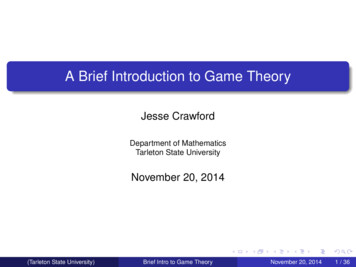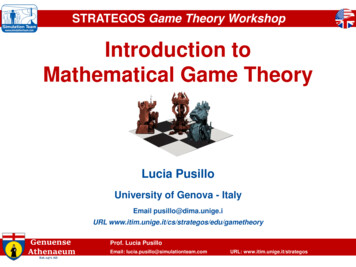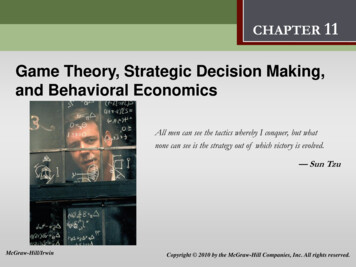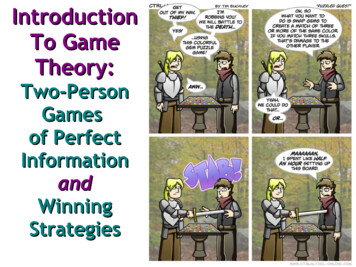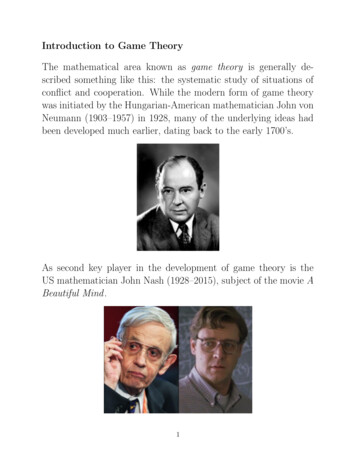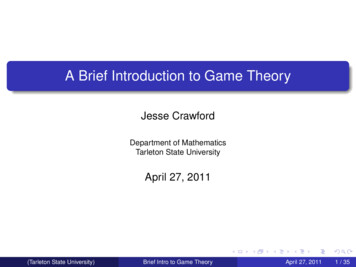
Transcription
Game theoryA Basic Introduction to GameTheory Field developed by economists to study social& economic interactions.– Wanted to understand why people behave theway they do in different economic situations.Effects of incentives. Rational explanation ofbehavior.Avrim BlumGame theory Field developed by economists to study social& economic interactions.– Wanted to understand why people behave theway they do in different economic situations.Effects of incentives. Rational explanation ofbehavior.Led to new subfield: AlgorithmicGame TheoryTheory and algorithms for systems of interactingagents, each with their own interests in mind. “Game” interaction between parties withtheir own interests. Could be called“interaction theory”. Big in CS for understanding large systems:– Internet routing, social networks, e-commerce– Problems like spam etc.Game Theory: Setting Have a collection of participants, or players. Each has a set of choices, or strategies forhow to play/behave. Combined behavior results in payoffs(satisfaction level) for each player.Most examples today will involve just 2 players(which will make them easier to picture, aswill become clear in a moment )Example: walking on the sidewalkstreet to drive on What side of sidewalk should I walk on? Two options for you (left or right). Samefor person walking towards you. Can describe payoffs in matrix:Left RightyouLeft(1,1) (-1,-1)Right(-1,-1) (1,1)Your payoff for RRpersonwalkingtowards youHis payoff for RR1
Key notionCould be randomized “Nash Equilibrium”: pair of strategies suchthat each player is playing a best-responseto the other. Neither has an incentive tochange.Example: prisoner’s dilemma Consider two companies deciding whether toinstall pollution controls. Imagine pollution controls cost 4 butimprove everyone’s environment by 3control don’t controlLeft RightyouLeft(1,1) (-1,-1)Right(-1,-1) (1,1)Your payoff for RRcontrolpersonwalkingtowards youHis payoff for RRdon’t controlgoalieLeft RightLeftshooter(0,0) (1,-1)GOAALLL!!!Right(1,-1) (0,0)For both, defectingis dominant strategy(3,-1) (0,0)What todoaddequilibrialook like here?Needextra incentivesto get good overall behavior.Example: matching pennies / penalty shot Shooter can choose to shoot left or shoot right. Goalie can choose to dive left or dive right. If goalie guesses correctly, (s)he saves the day.If not, it’s a goooooaaaaall! Vice-versa forshooter.(2,2) (-1,3)Nash (1950) Proved that if you allow randomized (mixed)strategies then every game has at least oneequilibrium. I.e., a pair of (randomized) strategies that isstable in the sense that each is a bestresponse to the other in terms of expectedpayoff. For this, and its implications, Nash receivedthe Nobel prize.Each playingNo50/50is a Nash equilibriumdeterministicequilibriumGame theory terminology Rows and columns called pure strategies. Randomized algs called mixed strategies. Often describe in terms of 2 matrices R, C.R1-1-11C1-1-11Basic facts (p,q) is NashEq if pTRq eiTRq 8i, pTCq pTCej 8j. ) for all i s.t. pi 0 we have eiTRq maxi’ ei’TRq ) for all j s.t. qj 0 we have pTCej maxj’ pTCej’R1-1-11C1-1-11(p,q) is Nash equilib if pTRq eiTRq 8i andpTCq pTCej 8j.2
NE can do strange things Braess paradox:– Road network, traffic going from s to t.– travel time as function of fraction x oftraffic on a given edge.travel time 1,indep of traffic1xstravel timet(x) x.– Road network, traffic going from s to t.– travel time as function of fraction x oftraffic on a given edge.travel time 1,indep of traffic12-Player Zero-Sum games Zero-sum games are the special case ofpurely-competitive 2-player games. Recall: an entry (x,y) means: x payoff to row player, y payoffto column player. “Zero sum” means that y -x. E.g., matching pennies / penalty shot:Left RightLeft(0,0) (1,-1)Right(1,-1) (0,0)1goalieGOAALLL!!!x0xFine. NE is 50/50. Travel time 1.5shooter Braess paradox:stxNE can do strange thingstravel timet(x) x.t1Add new superhighway. NE: everyoneuses zig-zag path. Travel time 2.Minimax-optimal strategies Minimax optimal strategy is a (randomized)strategy that has the best guarantee on itsexpected gain, over choices of the opponent.[maximizes the minimum] I.e., the thing to play if your opponent knowsyou well.goalieLeft RightshooterLeft(0,0) (1,-1)Right(1,-1) (0,0)GOAALLL!!!Minimax optimal for both players is 50/50. Gives expectedgain of ½ for shooter, -½ for goalie. Any other is worse.Minimax-optimal strategies How about penalty shot with goalie who’s weaker onthe left?Say shooter uses (p,1-p).- If goalie dives left, gets p/2 1-p 1 – p/2.- If goalie dives right, gets p.- Maximize minimum by setting equal.- Gives p 2/3.goalieLeft RightshooterLeft(½,-½) (1,-1)Right(1,-1) (0,0)GOAALLL!!!50/50Minimax-optimal strategies How about penalty shot with goalie who’s weaker onthe left?Minimax optimal for shooter is (2/3,1/3).Guarantees expected gain at least 2/3.Minimax optimal for goalie is also (2/3,1/3).Guarantees expected loss at most 2/3.Left RightshooterLeft(½,-½) (1,-1)Right(1,-1) (0,0)goalieGOAALLL!!!50/503
Minimax-optimal strategies Can solve for minimax optimal strategy using LinearProgramming:Variables p, v.Maximize v subject to: p Mj v, for all j. p is legal prob dist (pi 0, i pi 1).Left RightshooterLeft(½,-½) (1,-1)Right(1,-1) (0,0)goalieGOAALLL!!!50/50Minimax Theorem (von Neumann 1928) Every 2-player zero-sum game has a uniquevalue V. Minimax optimal strategy for R guaranteesR’s expected gain at least V. Minimax optimal strategy for C guaranteesC’s expected loss at most V.Counterintuitive: Means it doesn’t hurt to publishyour strategy if both players are optimal. (Borel hadproved for symmetric 5x5 but thought was false for largergames)Nash ) Minimax Nash’s theorem actually gives minimax thmas a corollary.– Pick some NE and let V value to row player inthat equilibrium.– Since it’s a NE, neither player can do bettereven knowing the (randomized) strategy theiropponent is playing.– So, they’re each playing minimax optimal.Nash ) Minimax On the other hand, for minimax, also havevery constructive, algorithmic arguments:– Can solve for minimax optimum using linearprogramming in time poly(n) (n size of game)– Have adaptive procedures that in repeated playguarantee to approach/beat best fixedstrategy in hindsight But for Nash, no efficient procedures tofind: NP-hard to find equilib with specialproperties, PPAD-hard just to find one.Simplified Poker (Kuhn 1950)Can use notion of minimaxoptimality to explain bluffingin poker Two players A and B.Deck of 3 cards: 1,2,3.Players ante 1.Each player gets one card.A goes first. Can bet 1 or pass. If A bets, B can call or fold. If A passes, B can bet 1 or pass.– If B bets, A can call or fold. High card wins (if no folding). Max pot 2.4
Two players A and B. 3 cards: 1,2,3. Players ante 1. Each player gets one card. A goes first. Can bet 1 or pass. If A bets, B can call or fold. If A passes, B can bet 1 or pass.– If B bets, A can call or fold.Writing as a Matrix Game For a given card, A can decide to Pass but fold if B bets. [PassFold] Pass but call if B bets. [PassCall] Bet. [Bet] Similar set of choices for B. A:And the minimax optimalstrategies are – If hold 1, then 5/6 PassFold and 1/6 Bet.– If hold 2, then ½ PassFold and ½ PassCall.– If hold 3, then ½ PassCall and ½ Bet. B:Has both bluffing and underbidding – If hold 1, then 2/3 FoldPass and 1/3 FoldBet.– If hold 2, then 2/3 FoldPass and 1/3 CallPass.– If hold 3, then CallBetCan look at all strategies as abig matrix [FP,FP,CB] [FP,CP,CB] [FB,FP,CB] B,PC,B]How to prove existence of NE Proof will be non-constructive. Notation:– Assume an nxn matrix.– Use (p1,.,pn) to denote mixed strategy for rowplayer, and (q1,.,qn) to denote mixed strategyfor column player.Minimax value of game is –1/18 to A.Proof We’ll start with Brouwer’s fixed pointtheorem.– Let S be a bounded convex region in Rn and letf:S ! S be a continuous function.– Then there must exist x 2 S such that f(x) x.– x is called a “fixed point” of f. Simple case: S is the interval [0,1]. We will care about:Proof (cont) S {(p,q): p,q are mixed strategies}. Want to define f(p,q) (p’,q’) such that:– f is continuous. This means that changing por q a little bit shouldn’t cause p’ or q’ tochange a lot.– Any fixed point of f is a Nash Equilibrium. Then Brouwer will imply existence of NE.– S {(p,q): p,q are legal probability distributionson 1,.,n}. I.e., S simplexn simplexn5
Try #1Try #1 What about f(p,q) (p’,q’) where p’ is bestresponse to q, and q’ is best response to p? Problem: not continuous: What about f(p,q) (p’,q’) where p’ is bestresponse to q, and q’ is best response to p? Problem: not continuous:– E.g., penalty shot: If p (0.51, 0.49) then q’ (1,0). If p (0.49,0.51) then q’ (0,1).Left RightLeft(0,0) (1,-1)Right(1,-1) (0,0)– E.g., penalty shot: If p (0.51, 0.49) then q’ (1,0). If p (0.49,0.51) then q’ (0,1).R 0110C 0-1-10Instead we will use.Try #1 What about f(p,q) (p’,q’) where p’ is bestresponse to q, and q’ is best response to p? Problem: also not necessarily well-defined: f(p,q) (p’,q’) such that:– q’ maximizes [(expected gain wrt p) - q-q’ 2]– p’ maximizes [(expected gain wrt q) - p-p’ 2]– E.g., if p (0.5,0.5) then q’ could be anything.R 0110C 0-1-10Instead we will use. f(p,q) (p’,q’) such that:pTCq’– q’ maximizes [(expected gain wrt p) - q-q’ 2]– p’ maximizes [(expected gain wrt q) - p-p’ 2]p’TRqp’pNote: quadratic linear quadratic.pTCq’p’TRqp p’Note: quadratic linear quadratic.Instead we will use. f(p,q) (p’,q’) such that:– q’ maximizes [(expected gain wrt p) - q-q’ 2]– p’ maximizes [(expected gain wrt q) - p-p’ 2] f is well-defined and continuous sincequadratic has unique maximum and smallchange to p,q only moves this a little. Also fixed point NE. (even if tinyincentive to move, will move little bit). So, that’s it!6
Algorithmic Game TheoryAlgorithmic issues in game theory: Computing equilibria / approximate equilibria indifferent kinds of games Understanding quality of equilibria in loadbalancing, network–design, routing, machinescheduling Analyzing dynamics of simple behaviors oradaptive (learning) algorithms: quality guarantees,convergence, Design issues: constructing rules so that game will(ideally) have dominant-strategy equilibria withgood properties.End of Game Theory Intro7
A Basic Introduction to Game Theory Avrim Blum Game theory Field developed by economists to study social & economic interactions. –Wanted to understand why people behave the way they do in different economic situations. Effects of incentives. Rational explanation of behavior. Game theory
